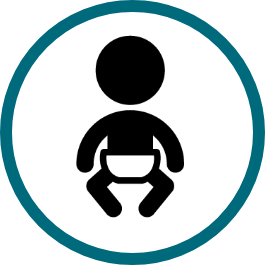Prompt diagnosis and appropriate care for newborn illness could reduce neonatal mortality by up to 30%.1Can available interventions end preventable deaths in mothers, newborn babies, and stillbirths, and at what cost?
The Lancet
Zulfi qar A Bhutta, Jai K Das, Rajiv Bahl, Joy E Lawn, Rehana A Salam, Vinod K Paul, M Jeeva Sankar, Hannah Blencowe, Arjumand Rizvi, Victoria B Chou, Neff Walker
2014 This is an occasional behavior that needs to be practiced without hesitation at the onset of danger signs of illness.

Care for Newborn Illness
Caregivers seek prompt and appropriate care for signs and symptoms of newborn illness
Key Points from Global Research
- Emphasizing caregiver knowledge and self-efficacy to recognize the danger signs of newborn illness and acknowledge the seriousness can ensure immediate care-seeking for newborns.
- Working within local structures to address social norms that define many practices in the first weeks of life can ensure families do not delay in seeking care for sick newborns.
Behavior Profile Sample: Care for Newborn Illness
A Behavior Profile is a summary analysis of each behavior. This sample draws from global evidence and illustrates the result of using the Create Behavior Profiles Tool to analyze factors, supporting actors and strategies and to ensure logical pathways exist between strategies proposed and factors related to the practice of the behavior. This sample may be used as a starting point or reference for creating Behavior Profiles.
| Improve maternal and child survival | |
|
Caregivers seek prompt and appropriate care for signs and symptoms of newborn illness Indicator: Percentage of last births in the two years preceding the survey who had their first postnatal checkup in the first two days after birth. The proxy indicator is based on the assumption that caregivers who attend a postnatal checkup within the first two days are more likely to know the danger signs of newborn illness and take action, and are also accessing care during a child's most vulnerable days.
|
Behavior Analysis |
Strategy | ||
|---|---|---|---|
STEPSWhat steps are needed to practice this behavior?
Click on any box |
FACTORSWhat factors may prevent or support practice of this behavior? These should be analyzed for each country context.StructuralAccessibility: Caregivers do not seek care for newborn illness because households are often far from health facilities, especially those with 24 hour services Accessibility: Caregivers do not seek care for newborn illness because when they deliver at home they may miss critical signs of distress in the first hours of a newborn’s life Service Provider Competencies: Caregivers do not seek prompt and appropriate care for newborn illness because the different phases of care (antenatal care, delivery, postpartum, and newborn) are not linked Service Provider Competencies: Caregivers do not seek care for newborn illness at a health facility because they often have a low perception of the quality of care they will receive at the clinic and prefer traditional medicine options SocialNorms: Caregivers do not seek care for newborn illness because some cultures have strict beliefs and practices relating to the first weeks of a newborn’s life such as the woman leaving the home or taking the newborn out of the home InternalAttitudes and Beliefs: Caregivers do not adhere to the full course of prescribed treatment because some medications (antibiotics) cause side effects that are not well understood and cause worry Attitudes and Beliefs: Caregivers seek prompt and appropriate care for newborn illness because they want a healthy baby Knowledge: Caregivers do not seek care for newborn illness because they do not always understand how quickly small problems can become major issues in a newborn, and they do not always recognize the early signs and symptoms of serious newborn illnesses |
SUPPORTING ACTORS AND ACTIONSWho must support the practice of this behavior?InstitutionalPolicymakers: Ensure clear linkages between maternal and newborn care and establish protocols for community-based postpartum and newborn home visits Providers: Offer counseling and support to pregnant women on newborn care and care-seeking at all touch points during pregnancy, delivery and in the first month of life HouseholdFamily Members: Learn signs and symptoms of newborn illnesses and encourage new mothers to feel comfortable in seeking skilled care for their infants Male Partners: Actively participate in ANC and support partner in learning about newborn care and care-seeking including planning for transport when and if it is required |
POSSIBLE PROGRAM STRATEGIESHow might we focus our efforts based on this analysis?Enabling EnvironmentPolicies and Governance: Ensure linkages between newborn health and postpartum care for mothers including community-based care options and home visits Systems, Products and ServicesQuality Improvement: Ensure clinics and providers adhere to rigorous quality standards including provision of counseling on drug side-effects and adherence Demand and UseCommunication: Provide education for caregivers during antenatal and postpartum visits on newborn illness and danger signs, including plans for emergencies Communication: Explore use of mobile phones and other innovative reminder materials to check in with new mothers in the first days post partum Collective Engagement: Engage husbands and family members in outreach and education during pregnancy to plan support for the new mother and baby Skills Building: Train TBAs or CHWs to conduct home visits with new mothers on day 1 and 3 of a baby's life to monitor the health of both mother and baby and provide referrals and counseling |
Global Status of Accelerator Behavior
Indicator: Percentage of last births in the two years preceding the survey who had their first postnatal checkup in the first two days after birth. The proxy indicator is based on the assumption that caregivers who attend a postnatal checkup within the first two days are more likely to know the danger signs of newborn illness and take action, and are also accessing care during a child's most vulnerable days.
The DHS Program Indicator Data API, The Demographic and Health Surveys (DHS) Program


 The Manoff Group was acquired by JSI in 2022.
The Manoff Group was acquired by JSI in 2022.